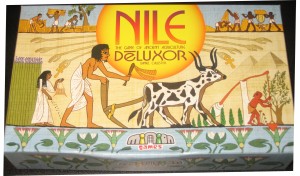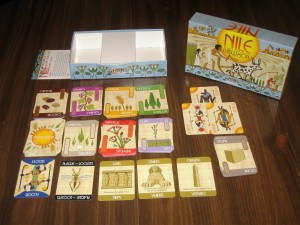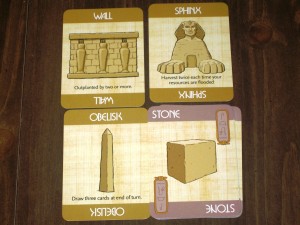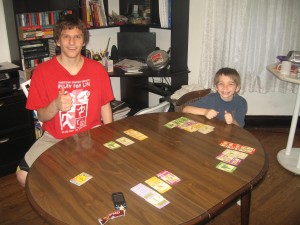Pop Quiz: What is the longest river in the world? Whether you pulled the information out of cobwebs from within the deep recesses of your brain or looked at the title of this article, you probably guessed it to be the Nile River. In ancient Egyptian agriculture, the Nile was essential in providing water to grow food as rainfall was scarce throughout the region. The lands near the Nile on either side were known as the floodplain, where the soil was the richest for farming.
Why the history lesson, you ask? Well, today we’re going to take a look at a game that pits players against each other using the very same setting: Nile DeLuxor. Before we get started, I want to extend a quick thank you to James Mathe from Minion Games for sending me a free copy to review.
Nile DeLuxor was released in 2011 and is a reprint of an older card game called “Nile”. On top of being an improvement over the original game, Nile DeLuxor comes with an expansion that introduces new stone and monument cards that can be either included or excluded from the original game.
Let’s take a quick look at the components, setup, and gameplay before going into the review. Please keep in mind that the below rules simply serve as a sample as to what players will be in for…if you are interested in the finer details, the manual is available online here:
Components
Crop Cards – There are seven different crop card types that players will see throughout the game. Players will be planting crop cards to create fields and are essential for winning the game.
Flood Card – This lone card is placed in the center of the table when the game starts and serves as a place for the cards that are drawn during the “flood phase”…more on that in a bit.
Speculate Cards – Speculate cards contain a number of different crops on them and can be played during the “plant or speculate phase.” You may also see them drawn during the “flood phase.”
Season Cards – These cards help players keep track of how many times they’ve gone through the deck and ultimately determines when the game will end.
Plague of Locust Card – Obviously, this doesn’t sound like a lot of fun. This card will eliminate all of the crops of the field that is currently the largest in play, regardless of who the owner of that field is.
Stone Cards & Monument Card (Expansion) – Stone cards are used in conjunction with monument cards in order to build monuments, which give their current owners special abilities during play. These are an optional addition to the game and can be excluded, should you wish them to be.
Setup
1. Place the flood card into the center of the table.
2. Remove two crop types from the deck if there are two to four players, one crop if there are five players, or keep them all if you have six players. Remove all of the speculate cards that feature these crops, as needed.
3. Keep the plague of locusts card aside for the time being and shuffle the deck. If you are going to play with the expansion, shuffle in the stone cards as well but keep the monument cards in the center of the table near the flood card.
4. Deal each player five cards, then shuffle the plague of locusts card into the deck. Pick a starting player at random.
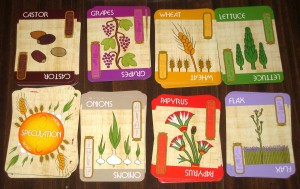
If you are playing with the expansion and have less than six players, I recommend removing the onions as their color tends to blend with the stone cards.
Gameplay
Every player’s turn is made up of five phases, which must be completed before moving on to the next player. The five phases are as follows:
Phase One: Flood
A card from the deck is drawn face up and placed onto the flood card. After the first turn, new cards will always replace the existing card shown. If anyone has a speculate card on the table, it is resolved…more on that in a moment.
Phase Two: Harvest
The player who has the crop that was revealed during phase one gets to harvest one of their crops from that field into their storage pile, which is later used for scoring.
If a speculate card is drawn, then all of the crops shown are harvested.
If the plague of locusts card is drawn, then the person with the most crops showing on any particular field must discard them. After resolving that, a new card from the deck is drawn to be resolved as normal.

If lettuce were to be drawn as the flood card, Vinnie Jr would place one of his lettuce into his storage pile.
Phase Three: Trade
The current player can trade two cards from either their hand or their storage pile in exchange for either of the following:
1. One new card from the draw deck to place into their hand.
2. One new card from the draw deck to act as the new flood card. When this happens, another harvest takes place and the new crop remains for future phases.
Trading is purely optional.
Phase Four: Plant or Speculate
The current player can either plant crops OR play one or two speculate cards.
Planting – If they decide to plant, they must observe the following rules:
1. They can plant at least two cards of the same type.
OR
2. They can plant EXACTLY two cards of different types, one of which MAY be added to an existing field.
OR
3. They can plant as many crops as they want onto an existing field.
Restrictions: Players cannot plant the crop type currently showing as the flood card. Players cannot plant a crop that another player is growing UNLESS they plant MORE crops than their opponent has showing in their field. When this happens, their opponent must discard all of those crops.
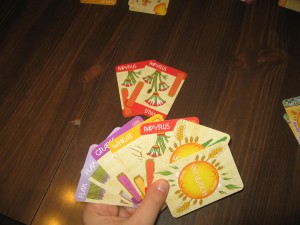
Wheat is currently the flood card, so I cannot play my speculate cards or my wheat card. I COULD add to my papyrus field and play one other crop, assuming no one else had it planted already. I could also play two flax cards, assuming no one else had two flax or more on their fields.
If players include the expansion, they will be drawing stone cards along with their crop cards. Players treat stone cards like they would a crop card and place them using the rules above. After placing stone cards, they choose a monument and place it on top of their stone pile. When stone is drawn during the flood phase, one stone is removed from everyone’s stone pile(s). A monument without stone goes back to the center of the table. Players can outbuild someone as they would a crop, using the same rules.
Speculating – Instead of planting, the player can play one or two speculate cards from their hand and place these cards on the table. During the next flood phase only, they compare the crops shown on the speculate cards with the flood card just drawn. For every card that they have a match for, they get to draw three cards from the deck. Speculate cards are discarded at the end of phase one.
Restrictions: Players cannot play a speculate card if it shows a crop that is also currently the crop in the flood pile.
Phase Five: Draw
The current player draws two card from the deck.
Should the deck run out, the deck is reshuffled along with the plague of locusts card and any other cards that may have been discarded. The next season “number” card is revealed so that players know how far along they are in the game.
Play continues clockwise, starting with phase one.
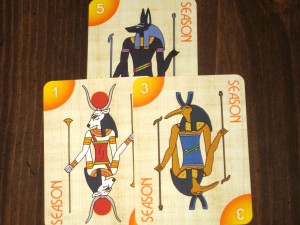
Season cards are double-sided. Simply flip over the new season or place the next season card on top.
Game End & Scoring
The game ends when a certain number of seasons have passed, which is equal to the number of people currently playing.
Players sort the crops that are in their storage area into piles. The number of piles total, going left to right, is equal to the number of crops being used in the game. If you have five crops in the game, you’ll have five piles, even if some of those piles are empty. Going left to right, you’ll place the crops you have the least of (starting from nothing) and work your way right to the crops you have the most of. The winner is the person who has the most crop cards in their leftmost pile. In case of a tie, you’d use the next leftmost pile, and so on.
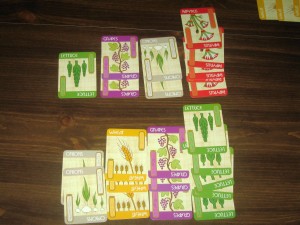
In this example, my son’s two onions beat my one lettuce. He also happened to beat the other three players at the table…2-1-1-0-0.
The Review
First, I’d like to commend the creators of this game for managing to make a card game that has fairly simple rules but offers a wide range of strategic play. I found that I was often thinking about which cards I should play and which cards I should hold onto until later. It seemed advantageous to play what you had so as to “control” the board. The more crops you have going at one time, the less options other players have.
I thought the game would take a while to play, seeing as how we had five players and thus had five seasons. I quickly discovered though that the later seasons were shorter since we were scoring cards in the interim, which results in the draw pile diminishing with every passing season. Season one took a good five to ten minutes whereas the fifth season was over within a few minutes. It balances out well into a nice thirty to forty-five minute game, depending on how many people are playing and how often they procrastinate.
I have to say, the kids picked up the rules very quickly. The biggest hurdle that they were often faced with was what they could and couldn’t play during the “plant or speculate phase”…after all, there are a lot of restrictions and stipulations as to what crops you can and can’t plant based on what is currently on the board. Once we played for a while, we got the hang of all of the special rules without having to consult the rulebook.
Vinnie Jr (11), Anthony Jr (16), Carolyn (13), and Jennifer (she’s not telling) all thought the game was fun and expressed interest in playing it again. They all couldn’t pinpoint why they thought the game was fun, just that it was. Jennifer, my girlfriend, can be picky when it comes to games and for her to admit that she’d play it again is high praise. We definitely have a winner for family game night.
I highly recommend this game to players of all ages. It serves as a great go-to game for when you want to introduce friends and family to the wonderful world of board games. Nile DeLuxor is simple enough to attract casual gamers but also in-depth enough to keep hardcore gamers from becoming bored…sort of a “not too hot and not too cold” deal.
Bottom Line: If you’re looking for a semi-casual card game that would appeal to all audiences, then you wouldn’t do wrong in picking up this little gem.
Final Verdict: 8/10
—
You can learn more about Minion Games by visiting their official site here:
You can learn more about and purchase the game by visiting Minion Games, Amazon, or Board Game Geek here:
Board Game Geek – Nile DeLuxor
—

